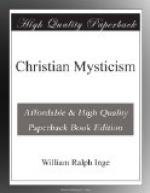The Trinitarian doctrine of Victorinus anticipates in a remarkable manner that of the later philosophical mystics. The Father, he says, eternally knows Himself in the Son. The Son is the self-objectification of God, the “forma” of God[189], the utterance of the Absolute. The Father is “cessatio,” “silentium,” “quies”; but He is also “motus” while the Son is “motio.” There is no contradiction between “motus” and “cessatio” since “motus” is not the same as “mutatio.” “Movement” belongs to the “being” of God; and this eternal “movement” is the generation of the Son. This eternal generation is exalted above time. All life is now: we live always in the present, not in the past or future; and thus our life is a symbol of eternity, to which all things are for ever present[190]. The generation of the Son is at the same time the creation of the archetypal world; for the Son is the cosmic principle[191], through whom all that potentially is is actualised. He even says that the Father is to the Son as [Greek: ho me on] to [Greek: ho on], thus taking the step which Plotinus wished to avoid, and applying the same expression to the superessential God as to infra-essential matter.[192]
This actualisation is a self-limitation of God,[193] but involves no degradation. Victorinus uses language implying the subordination of the Son, but is strongly opposed to Arianism.
The Holy Ghost is the “bond” (copula) of the Trinity, joining in perfect love the Father and the Son. Victorinus is the first to use this idea, which afterwards became common. It is based on the Neoplatonic triad of status, progressio, regressus ([Greek: mone, proodos, epistrophe]). In another place he symbolises the Holy Ghost as the female principle, the “Mother of Christ” in His eternal life. This metaphor is a relic of Gnosticism, which the Church wisely rejected.
The second Person of the Trinity contains in Himself the archetypes of everything. He is the “elementum,” “habitaculum,” “habitator,” “locus” of the universe. The material world was created for man’s probation. All spirits pre-existed, and their partial immersion in an impure material environment is a degradation from which they must aspire to be delivered. But the whole mundane history of a soul is only the realisation of the idea which had existed from all eternity in the mind of God. These doctrines show that Victorinus is involved in a dualistic view of matter, and in a form of predestinarianism; but he has no definite teaching on the relation of sin to the ideal world.
His language about Christ and the Church is mystical in tone. “The Church is Christ,” he says; “The resurrection of Christ is our resurrection”; and of the Eucharist, “The body of Christ is life.”




